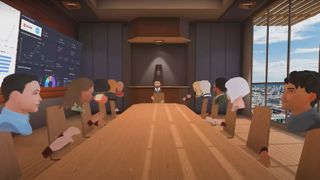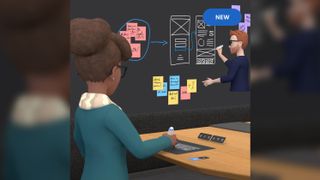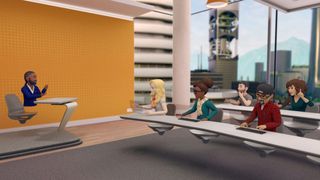Is it possible to work in VR?
Many applications make it easy to get work done in VR, so we thought we'd investigate.

While virtual reality headsets are perhaps most commonly used for gaming, there’s a lot more that can be done in VR and we ask the important question of is it possible to work in VR?
Thanks to the best VR headsets, VR has so much to offer. There are interactive VR experiences, live events, mindfulness exercises, as well as VR fitness apps, but what about doing actual work in VR?
While VR can give your office new dimensions, it also adds a sense of normality to those that still can’t travel back to their place of work – making users feel as though their colleagues are at the desk next to them.

It can also give your workflows new potential, be that through a creative process like drawing with your hands, video conferencing with an avatar, or just putting the content you’re working on front and center.
Whatever your reason for working in virtual reality, the good news is that it’s very possible, even at this nascent stage in the technology’s life cycle. Sure, you’ll find odd quirks, but you may be surprised at just how well everything works for the most part.
Why work in VR?
As we mentioned above, working in Virtual Reality has its own set of advantages. For one, it ironically might make you feel a little less isolated, particularly when working with a team that also has headsets – it’s a strange feeling to turn and see colleagues in a virtual office, especially if, like this writer, you’ve not set foot in one for over two years.

Then there are the more obvious boons – added focus on your current project, for example, or adding a whole new perspective to a project. It’s likely to be transformative for architects and CAD engineers, who will be able to manipulate objects with ease, or even step inside virtual buildings before they’re built.
However, it is an experience that takes some time to get used to. Having a screen with your employer’s Slack channel floating in front of your face is jarring at first, as is moving around without being able to see your surroundings. It won’t be for everyone, but there’s potential here.
Working in VR
In our time working in VR using the Meta Quest 2 (formerly Oculus Quest 2), we wanted to experience as much as possible within the headset – including the apps we use every day.
The Quest 2 offers connectivity with a PC (wired or wireless), and this meant it was able to replicate our PC desktop. In fact, it was able to replicate almost everything – our application shortcuts, our menus, and even our wallpaper.
Everything is just… there, divorced from a screen and hanging a foot from your face. There are other options, of course, that mean you can work from a spaceship or a cozy coffee shop, but doing so maps out the extremities of the room in a way that felt like a waste of processing power given that the Quest 2 is by no means a performance powerhouse.

We kept the connection wired, too, to avoid any battery or Wi-Fi-related-related dropouts in connection, and the headtracking worked smoothly enough without ever bringing on any sickness – at least once we’d acclimatized within an hour or two.
The biggest obstacle, as you can imagine, is using a keyboard and mouse. The Quest 2’s touch controllers are great for gaming, but using pointers for typing away on a PC was never going to fly in a text-based workflow. Thankfully, we were still able to write emails, articles, and Slack messages using the keyboard and mouse on the desk.
Were we less distracted? Honestly, yes. By taking the rest of the room out of the equation (and with audio playing through the headset’s speakers), we were able to get plenty of work done – at least until the meetings started piling up.


While all of your “flat” meeting apps will work in VR when mirroring a desktop, we wanted to put some alternatives through their paces and two stood out above the others.
There are a few options, each with different ways to show off your virtual avatar. Immersed, for example, lets users work within the same “room” and communicate with each other while collaborating on tasks. It lets each user create their own monitors out of thin air, and offers some fancy features like a remote whiteboard and screen-sharing for tasks that require teams. It supports plenty of applications, too, including Adobe suite for creative projects.

Meta also offers its own app, Horizon Workrooms. It’s still in beta, but will eventually give users the chance to connect within a virtual room, scribble on whiteboards, and type on virtual keyboards. It’s a bit strange seeing avatars without legs under the boardroom table, and the animations never feel particularly lifelike, but it’s a solid start that’s likely to improve over time.
And yet, we still found ourselves getting a little distracted in meetings. Perhaps it’s the novelty of head-tracking and looking at avatars, but we found ourselves preferring a Zoom, Google Meet, or Microsoft Teams call – at least for now.
Should you work in VR?
Surprisingly, we did find several situations where we worked better in VR than we do in our normal office set-up. Enclosing yourself in a virtual cocoon does wonders for your productivity by removing all the distractions of your home or office. Being able to touch-type is key though, as you're going to struggle to type at anything close to a reasonable rate with VR controllers and a virtual keyboard.
You should probably keep your VR working escapades for your working from home days though, as we imagine you'll draw quite a bit of mockery in the office if you turn up, say good morning and then jack into the Matrix for the day.
Virtual meetings seem to be a big part of the metaverse push from companies like Meta, but we found them to be a little gimmicky and distracting - Zoom or Google Meetings are far more efficient for now.
Sign up for the Live Science daily newsletter now
Get the world’s most fascinating discoveries delivered straight to your inbox.
Lloyd Coombes freelance tech and fitness writer for Live Science. He's an expert in all things Apple as well as in computer and gaming tech, with previous works published on TopTenReviews, Space.com, Dexerto and TechRadar. You'll find him regularly testing the latest MacBook or iPhone, but he spends most of his time writing about video games as Editor in Chief at GGRecon.com. He also covers board games and virtual reality, just to round out the nerdy pursuits.
